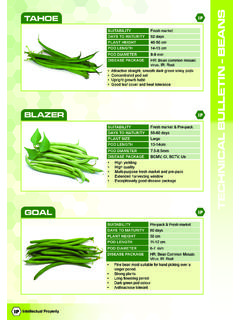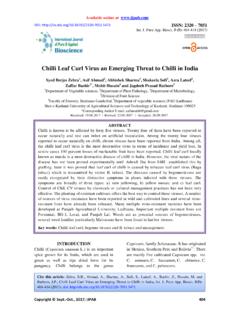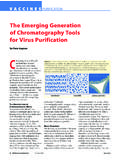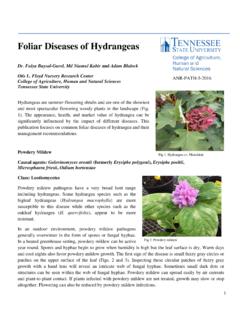Transcription of Evaluation of resistance to Tomato severe rugose virus ...
1 Tropical Plant Pathology 37 (5) September - October 2012314 Tropical Plant Pathology, vol. 37(5):314-318, 2012 Copyright by the Brazilian Phytopathological Society. Printed in RESEARCH ARTICLE / ARTIGOE valuation of resistance to Tomato severe rugose virus (ToSRV) in Capsicum spp. genotypesKelly Rocha , Julio M. Marubayashi , Tatiana Mituti , Ricardo Gioria , R mulo F. Kobori , Arlete Melo , Marcelo A. Pavan & Renate Krause-Sakate Departamento de Produ o Vegetal, Faculdade de Ci ncias Agron micas, Unesp, Rua Jos Barbosa de Barros, n 1780, 18603-970, Botucatu, SP, Brazil; Sakata Seed Sudam rica, Cx. Postal 427, 12906-840, Bragan a Paulista, SP, Brazil; Instituto Agron mico, Cx. Postal 28, 13012-970, Campinas, SP, BrazilAuthor for correspondence: Kelly Rocha, e-mail: severe rugose virus (ToSRV) is the predominant species of begomovirus in S o Paulo State, Brazil, and infects primarily Tomato and pepper plants.
2 There is no information about genetic resistance of pepper to this virus , so in this work the reaction of 29 genotypes of Capsicum spp. was evaluated by inoculation of two ToSRV isolates: ToSRV-Sk (isolated from a Tomato plant) and ToSRV-PJU (isolated from a pepper plant). For both isolates, two C. annuun genotypes (Catarino Cascabel - M xico and Silver) showed no symptoms 30 days after inoculation ( ). In a second experiment, these two genotypes were evaluated for 150 and, again, no symptoms could be observed. However, the virus was detected by RCA-PCR, indicating that both genotypes are susceptible, but less affected by ToSRV infection. Catarino Cascabel - M xico and Silver can be indicated for use in breeding programs for resistance of pepper to ToSRV. Key words: Bemisia tabaci, chili peper, geminivirus, tolerance, sweet sweet pepper (Capsicum annuum L.) is one of the ten most important vegetables cultivated in Brazil, consumed in natura and also used in the food industry.
3 Widespread damage by geminiviruses has caused low yields of peppers in some crop production areas in the world, causing serious economic impacts. Therefore, special attention has been given to the genus Begomovirus (family Geminiviridae) (Navas-Castillo et al., 2011). Members of this genus have a circular single-stranded DNA (ssDNA) genome encapsidated in twinned icosahedral (geminate) virions. Transmission by natural means is through the whitefly Bemisia tabaci Gen. (Hemiptera: Aleyrodidae) (Stanley et al., 2005; Navas-Castillo et al., 2011). Since the first report of begomoviruses in pepper in Brazil (Lima et al., 2001), B. tabaci belonging to the Middle East-Asia Minor 1 group, which includes the invasive populations of the commonly known B biotype (Dinsdale et al., 2010), has been frequently found in this crop, contributing to an increase in the incidence of these viruses, especially Tomato severe rugose virus (ToSRV), prevalent in S o Paulo state (Nozaki et al.)
4 , 2006; Rocha et al., 2010; Rocha et al., 2011) and widespread in Brazil (Fernandes et al., 2008). Brazil is considered one of the major diversity centers of the neotropical bipartite begomovirus cluster (Fernandes et al., 2008). In other parts of the world, at least fifteen different begomovirus species have been described infecting Capsicum spp. (Fauquet et al., 2008), but none of them has been detected so far in Brazil. Until now only ToSRV and Tomato yellow vein streak virus (ToYVSV) have been found infecting Capsicum spp. in this country (Nozaki et al., 2006). Plants of Capsicum infected by ToSRV show yellow mosaic and leaf distortion (Bezerra et al., 2006), yellowing of veins, chlorotic mottling and reduction of plant growth (Rocha et al., 2010).In a pepper breeding program, it is essential to characterize the available germplasm in order to develop pepper varieties resistant to begomoviruses.
5 Due to the scarce information on resistance of Capsicum spp. to begomoviruses, in this study we evaluated 29 genotypes of Capsicum spp. for ToSRV AND METHODSTwo ToSRV isolates were used, one from Capsicum annuum (ToSRV-PJU) obtained by Nozaki (2007) and one from Tomato plants (ToSRV-Sk) provided by Sakata Seed Sudamerica Company. Both isolates were maintained separately on Tomato plants of Santa Clara cultivar to avoid contamination of the identity of both isolates of ToSRV was confirmed via partial sequencing of the coat protein present in the DNA-A component. Tomato plants infected with ToSRV-Sk isolate showed stunting, severe leaf deformation and yellowing, while those infected with ToSRV-PJU isolate showed vein clearing and mild leaf mosaic. 315 Tropical Plant Pathology 37 (5) September - October 2012 Evaluation of resistance to Tomato severe rugose virus (ToSRV) in Capsicum spp.
6 GenotypesIn the first trial 19 genotypes of Capsicum spp. available in the germplasm bank of the Escola Superior de Agricultura Luiz de Queiroz (ESALQ) and of the Instituto Agron mico de Campinas (IAC), and 10 commercial genotypes were evaluated for their reaction to ToSRV-Sk and ToSRV-PJU (Table 1). The sowing of 10 plants of each genotype was done in expanded Styrofoam trays with 220 cells containing commercial substrate. The genotypes were divided into two trays each containing also Tomato cultivar Santa Clara as a susceptible control. Each tray was placed in a cage. The seedlings were maintained in a greenhouse and were whitefly inoculated with the virus isolates 30 days after B. tabaci collected on sweet pepper plants were maintained in a greenhouse with anti insect nets, on collard green (Brassica oleraceae L. var. acephala) and soybean (Glycine max) plants, which are non-host of ToSRV species.
7 The whitefly species was identified by using PCR-RFLP analysis and sequencing the mtCOI gene (Rocha et al., 2011). For ToSRV-PJU transmission, adult insects were collected from collard green and soybean plants with the aid of a glass tube mouth aspirator. The insects were transferred to small cages containing branches of Tomato plants infected with ToSRV-PJU. Approximately 1,000 insects were placed in each cage, which were kept in a dark room maintained at 30 C for an acquisition access period (AAP) of 24 hours. Following the AAP, around 5000 whiteflies were transferred to the cages containing 80 seedlings per tray (average of 50 insects per seedling) for an inoculation access period (IAP) of seven days. Following the IAP, the plants were sprayed with insecticides (imidacloprid after IAP and acefate plus buprofezin one week later, always using the manufacturer s recommended dosage) to eliminate the whitefly adults, nymphs, and eggs.
8 The plants were kept in a greenhouse at 25 to 30 C for a period of 30 transmission of the ToSRV-Sk isolate, whiteflies were reared on infected Tomato plants, in an air-conditioned room (28 C and 80% RH). The polystyrene trays containing pepper seedlings were placed in the same room and the vector population was maintained on an average of 50 insects per pepper seedling. The IAP was of seven days, after which the seedlings were exposed to the same treatments and conditions described for inoculation of the ToSRV-PJU isolate. For both isolates, Tomato plants from the cultivar Santa Clara were inoculated in the same conditions as positive control. Symptom and the virus presence by PCR analysis was evaluated 30 days after inoculation ( ). Total DNA was extracted from the 10 plants of each genotype following the protocol described by Dellaporta et al. (1983). The PCR Master Mix (Promega) pre-mix and the oligonucleotide pair GemiA1202s 5 TGG TAG ACT CTG CTC GCG G 3 (sense) and GemiA1876a 5 CTC TTT CAC TAG CGT ACC G 3 (antisense) (Nozaki, 2007), which are directed to part of the gene that encodes the Rep (AC1) and the Trap (AC2) genes, were used in the PCR reaction.
9 These primers are useful for detection of both isolates. The program consisted of initial denaturation at 95 C for 2 minutes, followed by 40 cycles at 94 C for 40 seconds, annealing at 54 C for 1 minute, and extension to 72 C for 1 minute, with a final extension step at 72 C for 10 minutes. The amplified (~670bp) DNA fragment was submitted to gel electrophoresis in agarose and stained with ethidium to the promising results obtained in the first trial for the accessions Catarino Cascabel - M xico and Silver, fifteen plants of each genotype were re-inoculated with just the more aggressive isolate, ToSRV-Sk, following the same conditions previously described and evaluated for 150 Santa Clara Tomato cultivar and C. annuum (8752-1) were used as susceptible controls. All seedlings were transplanted individually into a 5-liter plastic pot and maintained into a fertirrigation system.
10 The presence of symptoms and virus was evaluated during the period of 150 days. Total DNA from the leaf tissue of the apex of the plant was extracted using the same protocol previously described. Molecular analysis was performed by rolling circle amplification (RCA), a more sensitive method suitable for begomovirus detection (Inoue-Nagata et al., 2004; Haible et al., 2006), followed by PCR amplification of part of the DNA-A component with the same primers used previously, Gemi1202s/Gemi1876a. PCR amplification products were analyzed in agarose-gel electrophoresis stained with SYBR Safe (Invitrogen).RESULTS AND DISCUSSIONAll Tomato plants from cultivar Santa Clara used as susceptible control were infected by both isolates, indicating that the whiteflies were viruliferous and the virus infective. The appearance of symptoms on inoculated plants caused by ToSRV-Sk occurred earlier than on those inoculated with isolate ToSRV-PJU.
















